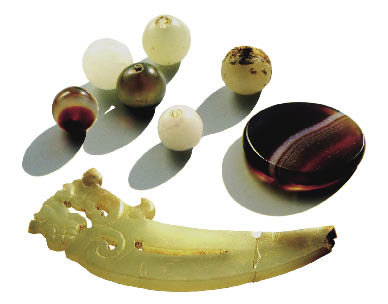| Cao Cao's Tomb Comes to Light
By staff reporter ZHANG XUEYING
THE ghost of Cao Cao, a figure from the Three Kingdoms Period (220-265), reaches from his grave of 1,800 years to stir up the controversy that has surrounded him for centuries. The discovery of his tomb in Anyang City, Henan Province created quite a national sensation when it was announced in Beijing on December 27, 2009 by the Henan Provincial Cultural Relics Bureau. Ancient officialdom split with the people at large on the issue of what kind of ruler Cao Cao was: recorded history in the following dynasties was mostly laudatory, while folk literature largely derogatory. The Romance of the Three Kingdoms, in particular, described him as a crafty, underhanded character and labeled him a "usurper of imperial power" who "kidnapped" the emperor so as to "lord it over vassals." The influence of this ancient classic novel on popular opinion was fatal to Cao Cao's reputation; he was always depicted as a bad guy – on the stage, in imagery, and in oral or printed accounts throughout the following centuries.
 |
|
Stone tablets engraved with inscriptions referring to “King Wu of Wei.” |
Cao Cao (155-220) rose to power by employing political shrewdness and leveraging military resources in the chaotic period of the late Eastern Han Dynasty (25-220) when central supremacy was challenged by defiant local warlords locked in their own violent rivalries. In AD 200, Cao Cao clashed with the powerful warlord Yuan Shao at Guandu (present-day Zhongmou County in Henan Province), and established his everlasting fame. The Guandu Battle was recorded by ancient historians as one of the three exemplary ancient military maneuvers in which the weak defeated the strong and the minority overpowered the majority. Cao Cao defeated troops that were not only better equipped than his own, but outnumbered his men by a factor of ten to one. The last time he reputedly meddled with the odds it kept his burial site the subject of speculation centuries after his death.
Cao Cao's burial site is important, since he soon rose to the status of Emperor. Following his stunning military career highlight, Cao Cao became prime minister to the puppet Emperor Xiandi of the Eastern Han Dynasty and exercised the power behind the throne. In 213 Emperor Xiandi was forced to make Cao Cao King of Wei, headquartered at Yecheng near present-day Anyang in Henan Province, and conferred on him the same regal privilege as that of the emperor himself. Less than a year after Cao Cao's death, his son Cao Pi forced Emperor Xiandi to abdicate – thus the Han Dynasty was terminated – and claimed himself Emperor Wen of Wei. Meanwhile, he changed the posthumous title of his deceased father from "King Wu of Wei" to "Emperor Wu of Wei."
The location of Cao Cao's tomb is a mystery we may be about to solve. He was reputed to be secretive, and a legend grew up that he went to the trouble of having 72 grave mounds built. On the day of his funeral, all the gates of Yecheng were kept wide open, and 72 coffins were carried simultaneously out of the East, West, North and South gates to 72 different burial sites, making the chances of finding the real grave quite slim. According to historical records, however, Cao Cao died of illness at the age of 66 in present-day Luoyang, Henan Province and was buried at Gaoling, or the High Mausoleum. The site of the current discovery is, more precisely, on a piece of raised land near Xigaoxue Village of Anyang City, 15 kilometers west of the ancient ruins of Yecheng.
As a center of early Chinese civilization, Henan is studded with ancient tombs; many of them are kept intact in order to protect the buried treasure. Between 2006 and 2008, the Xigaoxue tomb area was robbed several times. To prevent further damage and loss of cultural relics, a team from the Henan Provincial Institute of Cultural Relics and Archaeology started a rescue excavation in December 2008. By late 2009 – in spite of several robberies – they salvaged 250 restorable artifacts, including inscribed stone tablets, iron armor and weapons – all broken – that provided information on the identity of the entombed.
|
